What if 3D printing could revolutionize baking and cooking? The project is still under construction.
Jonathan Butlinger, an engineer at Columbia Engineering in New York, has in any case split a study in this direction, taking as an example a cooperative dessert, but a bit recalcitrant: the cheesecake.
3D printing hits the spot
After repairing damaged internal organs and tissues, 3D printing could be applied to the culinary field. Such an initiative had already been launched last year in France in the field of pastry, with the model called “Patiss3”.
Jonathan Butlinger wants to push the idea further by applying 3D printing in the kitchen in the broadest sense. Since you have to start somewhere, the engineer set his sights on cheesecake. By mixing dough and powder through seven different ingredients (including cookie dough, peanut butter, and Nutella, among others), he was able to 3D print the cake. It took about thirty minutes to achieve this result.
However, this did not go smoothly and a first convincing result could only be produced after five attempts. It is indeed necessary to indicate to the 3D printer an adequate shape and well-proportioned layers to prevent everything from falling flat, as was the case in the image above.
Today the cheesecake, tomorrow the rest?
For science, Jonathan then tasted the 3D printer’s culinary creations, even failed ones. ” They definitely taste like something I haven’t tried before. I rather liked it, but it’s not a conventional mix. We are not Michelin chefs “.
The engineer indicates that, beyond the cheesecake, his experiments have shown that it is also possible to print chicken, beef, vegetables or even cheese, even if the results are for the moment inconclusive. ” Anything can be printable, and I think such development is inevitable. Once software hits an industry, there’s no going back “. He envisions a future where a 3D printer can be combined with a laser stove, all of which can be installed in any home.
However, researchers and food specialists outside the project view things more pessimistically. Some believe that 3D printing of food in restaurants and the like risks distorting the practice of cooking and misleading customers, who will not be aware of the “unnatural” aspect of the thing.
Still others worry that to make foods like vegetables or fruit easier to print, you would have to cut out the healthier nutrients like fiber. This would deprive 3D foods of essential elements like vitamins or minerals. The future will therefore tell us if 3D printing is ready to get its hands dirty, and under what conditions.
Source : Nature

14